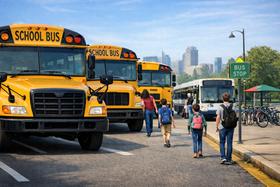Online High Schools are a non-traditional form of education that uses the internet to deliver distance education. This type of online education is offered by existing traditional high schools (both public and private), universities, charter high schools and private cyber high schools.
There are several types of online high schools:
Cyber charter schools are identical to normal bricks and mortar charter schools, except that the learning is delivered to the students via the internet. As with traditional charter schools, cyber charter schools are self-managed, and receive state or federal funding to support their existence. Online charter schools follow the guidelines set by local school districts, but offer flexibility in terms of curriculum and set-up. Students can enroll at online charter schools free of charge and are normally issued with computers and free dialup access. There are approximately 31 virtual charter schools in 12 states that can provide an online education. Those states include Alaska, Arizona, California, Idaho, Kansas, Minnesota, Nevada, New Mexico, Ohio, Pennsylvania, Texas, and Wisconsin. Some of these schools are:
- 21st Century Cyber Charter School [est. 1999] http://www.21stcenturycyber.org
- Pinnacle Charter High School [est. 1998] http://www.pinnacleeducation.com
- Choice2000 [est.2003]
Online Private High Schools
Online private high schools are similar to regular private high schools. They are funded privately, so students need to pay tuition when enrolling. This can become rather expensive. The list of accredited high schools below was recommended by Online High Schools – http://www.cyberhighschools.com:
- Penn Foster Career School [est. 1932] http://www.pennfoster.edu/
- Center for Distance and Independent Study – University of Missouri Columbia [est. 2004] https://www.davidsongifted.org/search-database/entry/r14403
- CompuHigh [est. 1994] http://www.compuhigh.com
Online Public High Schools
Online public schools are cyber extensions of traditional government run public schools. They receive government funding and abide by government rules and regulations. They offer greater flexibility in terms of subject choice and variety, schedules and so forth. State funded online high schools can be found in several states, including: Alabama, Alaska, Arizona, Arkansas, California, Colorado, Illinois, North Carolina, and Pennsylvania. Examples include:
- Alabama Online High School [est. 2000] http://www.onlineschools.com/high-school/alabama
- North Carolina Virtual Public School [est. 2002] https://ncvps.org/
- Sequoia Choice School Arizona Distance Learning School [est. 2003] https://www.sequoiachoice.org/
How do Online High Schools Work?
Instead of attending school in a traditional setup, students ‘attend’ classes on the internet. Notes are provided with each lesson and the students still make use of textbooks. These textbooks are provided free of charge to both Cyber Charter and Online Public High Schools, although the student has to pay for postage if he or she lives outside the State where the school is physically located. Online Private High School Students are normally required to purchase their textbooks from the school’s book store.
The presentation of the lessons differs greatly from one school to the next. Some private Online High Schools, like Keystone College, offer their lessons by means of interactive multimedia presentations. This is not necessarily a practical option for Cyber Charter High Schools, as the access provided is dial-up.
In Private Online High Schools, students can contact a qualified teacher via telephone, email and sometimes via a Chat facility. The teachers in these schools play the primary educational role next to the lessons offered. Online Public and Cyber Charter High Schools, consider the parent as the primary educational role player after the lessons, with teachers fulfilling a secondary role. Access to teachers are telephonic and via email.
Tests, Exams and Quizzes are taken online. This does leave a wide berth for irregularities to take place. The online schools tend to defend this by saying that insight into the material is required in order to pass, but that does not really prevent a student from calling on somebody else to take a test or sit an Exam on his or her behalf. It is left to the integrity of the parent and the student at this point in time not to cheat.
How many US students attend online high schools?
Due to the rapid proliferation of online high schools, and because no nationally representative study had been undertaken, the US Department of Education requested that a survey be conducted to gain some of the insights lacking for the 2002/3 school year. The study covered, amongst others, technology-based distance education availability, course offerings and enrolments.
Unfortunately, only public high schools were to be targeted. No study has to date been undertaken to include private- and charter high schools and universities delivering online high school courses.
Of relevance to this report is that the resultant survey found that:
- 36% of all public schools had students enrolled in distance learning, of which 68% were public high schools.
- 43% of the public high schools that offer distance learning made use of the internet as a delivery method
Based on the findings of the survey, it means that there were approximately 95,000 online high school students for the 2002/3 school year. Just how many students are enrolled for online distance education through private schools and other private entities cannot be established due to a lack of studies and statistics.
In spite of these figures being the most current official data available, it is old. In the NCES survey, 70% of the public high schools indicated that they intend expanding their online schooling capability. However, no projections were made in terms of the expected annual growth in online high school students.
To form a rough idea of the current online high school attendance, one could probably use the official cumulative growth statistic of +/- 34% from 1999 to 2003 for Grades 9 to 12 home schooling students . If the same growth holds true for cyber schooling, and if this cumulative growth rate remained constant from 2003 to 2007, there could be as many as 127,000 online high school students enrolled at online public high schools at present.
Why are high schools expanding to online schooling?
The NCES survey also sought to establish why schools were expanding their services to students by offering online schooling. The reasons quoted were:
- Offering courses not otherwise available at school
- Offering Advance Placement / College level course
- Growing population and limited space
- Scheduling conflicts
- Meeting the needs of specific groups of students
- Allowing students to retake failed courses
Why do parents opt to move away from traditional schooling?
According to the Population Division of the US Census Bureau , parents’ reasons for moving away from the traditional schooling system included the following:
- 30% cited that regular schools have a poor learning environment;
- 14% objected to what was being taught at school;
- 11% felt that their children were not being challenged sufficiently at school;
- 33% cited religion;
- 9% quoted morality.
Having said this, attendance of an online high school does not necessarily imply a complete move away from traditional schooling. There are many students that attend traditional schools, but make use of cyber education to:
- Take courses not offered by their school;
- Take courses with scheduling challenges;
- Re-take previously failed course/s;
- Take advance placement courses;
- Take additional courses.
There are other further advantages to online high schools:
Pace setting - Humans are diverse. There are gifted learners, average learners and slower learners. Aptitude is a further dimension to be considered. The ability to set their own pace in any given lesson, in accordance with their abilities and aptitudes, could afford students the opportunity to properly absorb and understand the information presented before moving forward.
Accessibility – Online high schools offer the opportunity to many students who would have had to attend boarding schools otherwise, to remain with their parents. Examples:
- Special needs students;
- Students in rural areas;
- Students in areas lacking good schools.
Flexibility - It also offers an opportunity to students who frequently missed school due to circumstances to remain current with their schoolwork due to time and place flexibility. Examples:
- Students with creative and sport careers;
- Students who suffer from health challenges.
Individual attention - Online schooling creates an artificial one-on-one teaching situation. This means that the student can focus on the lesson at hand, without distractions from other children, while having access to somebody (parent or teacher) who can explain, guide and assist if anything is not grasped or clearly understood. This particularly benefits ADD and ADHD children.
There are, however, some potential drawbacks:
Student Willingness – If a student prefers studying in a traditional setup and does not want to study online, chances are that he or she won’t benefit.
Student Suitability – Not all students are suited to cyber education. There are many factors impacting suitability, including:
- Motivation: To benefit from online education, students need to be self-motivated as they would be working without the constant encouragement and input from an ever-present teacher.
- Reading Skills and Comprehension: Above average reading skills of comprehension is also necessary, because the student will have to read the curriculum and study material in many cases.
- Typing Ability: If a student cannot type at a reasonable speed, he or she may have difficulty completing assessments on time.
- Self-discipline: There is a risk that the student could end up surfing the web or playing internet games instead of focusing on the course material if he or she is not self-disciplined.
Socializing – Social development can be hampered if teenagers are deprived of social contact with their peers. As with all forms of distance education this requirement for socialization, presents a social adaptability risk. When making the decision on whether online schooling is appropriate for a student, there are three factors that could improve the circumstances:
- Location:If the student is in the proximity of the school’s physical location, it means that he or she can attend those field trips, social days and so forth invariably organized by the online high schools.
- Friends: If the child has many friends of a similar age in his or her neighborhood, it means that he or she can ‘hang out’ with them and participate in the group context.
- Sport and Culture: If the student participates in a sport or in a cultural activity that encourages social contact, the impact of the lack of face to face contact will be negated, provided that the participation is on a frequent basis.
Studies undertaken by the HSLDA have shown that nearly a half of the children outside the traditional school setup participate in sport, that 98% participate in two or more extramural activities, that 87% had friends outside the family circle and that 84% participated in field trips.
Considerations When Evaluating Online Education
When choosing an online high school, parents should also take the issues below into consideration:
- Teachers - Teachers must be appropriately qualified in the subject matter they are responsible for and be able to effectively work in an online environment. Check if the school offers extra assistance to students by means of direct communication to teachers and what the student-teacher ratio is.
- Curriculum - The Curriculum must be relevant and comply with the appropriate state standards for student learning. The course design should promote the active participation of the student and allow interaction with both the teacher and his or her online classmates in the course. Make a point of looking at the Curriculum to see whether the online school you wish to attend offers the courses you need. Check the duration of these courses and whether you have the option of completing it in a shorter time span if you need to. Some online schools allow students complete flexibility whereas others have fixed schedules and deadlines. Some schools have virtual class sessions where students are required to attend.
- Assessment - Assessments should take place at regular intervals so as to provide the student with feedback on his or her progress. The assessments should require demonstrable skills and insight on the relevant subject matter.
- Technological Infrastructure - The technology used to deliver the course material must be reliable, available, simple and economical. Technical support must be available to both students and teachers at any time. The student will need a computer that is updated and able to run the latest word processing and multimedia programs. Sound and a decent graphics card are a must. Establish whether the online program you choose, will require of you to invest in additional software or if the additional software required (if any) is included in the tuition costs.
- Online school accreditation - A school’s policies and programs have to meet certain minimum criteria set by an outside agency to be granted accreditation. Accreditation of a school is very important as it can influence the future of students enrolled at the school. Accreditation is a protective tool for schools, students and employers alike. It endorses and gives credit to schools that meet their standards and ensures that students are being taught at a level that is nationally acceptable. Likewise, employers prefer to hire students who have graduated from accredited schools as they can be assured that the student has received a certain standard of educations. Students graduating from accredited online schools should have the same chance of being granted admission to colleges as students who graduate from traditional schools provided that they have completed a college prep diploma from an accredited online high school, and that their grades meet the admission requirements. Several reputable Universities (such as Nebraska, Miami, Missouri etc), are involved with online high schools nowadays. The important thing here is to ask the school by which Regional Agency they were accredited, to contact the Department of Education to verify whether the accreditation agency is in fact approved to perform accreditations and then to contact the agency to get a reference on the school. The school needs to be accredited by one of the regional accreditation agencies. Also ask for the school’s rating with the State’s Department of Education and a copy of the annual evaluation report. It will offer a balanced view of the school’s ability to maintain the required educational standards. This is a good precaution to take – regardless of whether the school is online or traditional!
Cost of Online Schooling
Only Online Private High Schools charge fees. The fees and fee structures vary greatly. Stationary, computers, text books and internet access are normally not included in the tuition fees paid to the private school. Here are two examples:
- Penn Foster – As at May 2007, the total price for the complete 21.5 credit Penn Foster High School Diploma Program is $985.00. This includes tuition, a registration fee, a credit application fee, a technology fee as well as shipping and handling charges. Tuition includes one on one contact with the teachers and the Diploma is both for general and college prep.
- CompuHigh – As at May 2007, CompuHigh, which is a Whitmore School, offers two complete Diploma packages: High School Diploma and High School Diploma Plus at $985 and $1,485 respectively. Whilst both Diplomas are for general (18 credits) or college prep (22 credits), and whilst both offer one-to-one contact with teachers, the Plus Diploma also provides: a personal education counselor weekly progress report plus a monthly overview – both of which are submitted to the student’s parents via email, phone calls to the parents as needed, monitoring of the student's progress by his or her counselor, and intervention by the student’s counselor when necessary.
Cyber Charter and Online Public High Schools normally do not charge for tuition and textbooks. Whilst Online Public High School Students may have to procure their own Computer and Internet Access in some instances, Cyber Charter Schools issue these to their students as a rule at no charge.
Conclusion
The process of selecting an online high school should not materially differ from the process of selecting a traditional high school. Save for the technology criteria, the remainder of the considerations are very much the same. Eventually, the quality of the online high school experience will depend as much on the suitability of the individual student as on the credentials of the institution where he or she is enrolled at.












